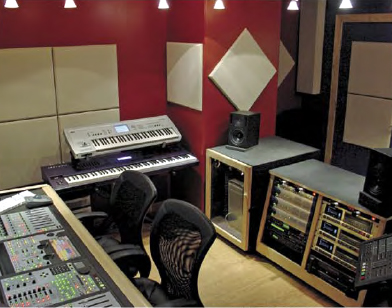As part of my Critical Listening class with Berklee Music Online I’ve been spending a lot of time tweaking my audio mixing room. The point is to level out the environment at the listening position for an audio response that minimizes comb filtering and nodes that cancel out frequencies. If the problem is not minimized, at least knowing the frequency problem areas can give you crucial information so you don’t over adjust in the final mixes.
Here’s the short run down for others that want to do acoustic treatment for the audio mixing position:
- Play sine tones all set to the same level through your speakers. Measure those with an SPL to see which frequencies are playing softer. These may be frequencies where some cancellation is happening. Be sure to check your speakers frequency response; frequency changes below 500Hz and above 8Khz may be due to speaker specs.
- Tones below 500Hz are the most difficult to treat because of the length of the waves. For example a 40Hz signal wave is in the ballpark of 20 feet. For this reason, most absorption materials are only going to effect the higher frequencies that can impact shorter waves. For example 10k is around three inches. wavelength = (propagation speed) / frequency
- Main Treatment Areas – As a starter, main treatment areas are wall behind speakers, side wall reflections (use mirror on wall to see reflection point) and back wall diffusion and/or absorption. Take care not to overdo absorption. Overall, opt for a reflective floor and diffusive/absorptive ceiling rather than vice versa. Beyond that, bass traps can be used in corners and back wall where lower bass frequencies tend to gather. Diffusion is most commonly used on ceiling and back wall but will probably only affect mid and higher frequencies.
- Homemade Treatments – If you have the patience, skill and time it’s possible to make your own diffusors and absorbers. There are many examples online using rock wool and other materials. For premade solutions check out RPG and Auralex.
- Speaker Positioning – Speakers should form an equilateral triangle to listening position, away from wall to minimize bass frequency reflection, preferably on their own stands behind desk or console to minimize reflection from mixing surface area, tweeters at ear level, rotated symmetrically inward 30 degrees toward listening position.
httpv://www.youtube.com/watch?v=I3q5kQjMAbc
* Photo at beginning of post is not MY audio mixing room – just an example of applied panels.
